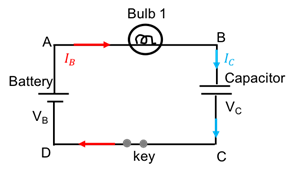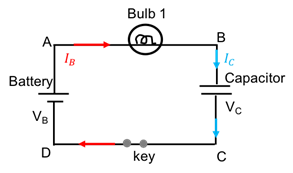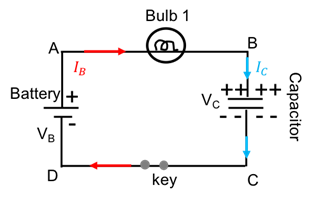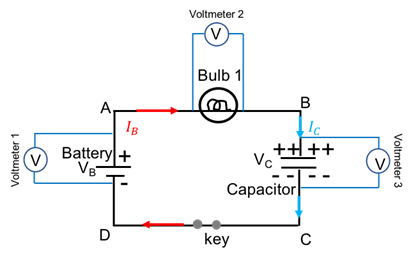
A capacitor is connected to a battery, bulb, and switch as shown. Assume that the switch has been closed for an extended period of time.

1. Predict whether the brightness of the bulb is the same as, greater than, or less than the brightness of a single bulb connected to a battery. Explain.
2. Predict how the potential difference across the battery to the potential differences across the capacitor plates and to the potential difference across the bulb. Explain.
3. Briefly describe the distribution of charge, if any, on the capacitor plates.
Recall the relationship between the charge on a capacitor and the potential difference across the capacitor. Use this relationship to describe how you could use a voltmeter to determine the charge on a capacitor.
4. Obtain the circuit and a voltmeter. Check your predictions for parts 1 and 2.
(1)
To Explain:Whether the brightness of the bulb is the same as, greater than or less than the brightness of a single bulb connected to a battery.
Answer to Problem 1aT
Brightness of the bulb changes with the time in RC circuit but it is constant in case of battery only.
Explanation of Solution
Introduction:
Ohm’s Law: The current in the circuit is directly proportional to the potential difference and the constant of proportionality is known as resistance R.
The potential difference across the capacitor is given as:
Where,
A RC circuit with a battery connected to the capacitor through a Bulb with a resistance of

Figure 1: A RC circuit with a battery, bulb and a capacitor
After a long time, the circuit will behave as an open circuit and Therefore, current in the circuit drops to zero with the time till the capacitor voltage equals to the battery voltage.During initial moment, the brightness of the bulb in this RC is equivalent to the single bulb with the battery.But as the time passes, current starts dropping, hence, brightness decreases till the circuit becomes open due to the charging of the capacitor.
Conclusion:
Brightness of the bulb changes with the time in RC circuit but it is constant in case of battery only.
(2)
To Compare: The potential difference across capacitor, bulb and battery.
Answer to Problem 1aT
The voltage difference between the terminals of the battery is
Explanation of Solution
Introduction:
Ohm’s Law: The current in the circuit is directly proportional to the potential difference and the constant of proportionality is known as resistance R.
The potential difference across the capacitor is given as:
Where
A RC circuit with a battery connected to the capacitor through a Bulb with a resistance of

Figure 2: A RC circuit with a battery, bulb and a capacitor
The voltage difference between the terminals of the battery is
Hence, the voltage through the loop can be written as:
Conclusion:
The voltage difference between the terminals of the battery is
(3)
Charge distribution on the plates of the capacitor.
Answer to Problem 1aT
One of the plates accumulates positive and other negative charge in equal magnitude.
Explanation of Solution
Introduction:
The charge on the capacitor is directly proportional to the potential difference across the capacitor plates,
Where ‘C’ is the constant known as the capacitance which depends on the material and design property of the capacitor.
In given circuit, shown in Figure 3, the positive terminal of the battery is connected with the upper plate of the capacitor and the lower one with negative terminal of the battery.

Figure 3: Charge distribution on the capacitor
Current flows from positive terminal of the battery to towards the bulb. Basically, current is in the opposite direction of the flow of the electrons. Electrons from the upper plate of the capacitor starts moving towards positive terminal of the battery and leaves the upper plate positive and electrons in the lower plate are repelled from the negative terminal of the battery. This accumulation of the charge happens till the potential difference across the plate is equal to the battery voltage. Also, the charge on the plates is equal in magnitude and opposite in charge.
Conclusion:
Hence, one of the plates of the capacitor accumulates positive and other negative charge in equal magnitude.
(4)
To Check: The predictions using voltmeter in the circuit.
Explanation of Solution
Introduction:
Ohm’s Law: The current in the circuit is directly proportional to the potential difference and the constant of proportionality is known as resistance R.
The charge on the capacitor is directly proportional to the potential difference across the capacitor plates,
Where ‘C’ is the constant known as the capacitance which depends on the material and design property of the capacitor.
In given circuit, shown in Figure 4, voltmeters are connected parallel to the battery, bulb and the capacitor in order to observe the potential for each circuit element after capacitor is fully charged. Once the capacitor is fully charged, circuit becomes open circuit and hence, no current flows through the circuit.

Figure 3: Circuit to calculate Vpotential across battery, bulb and the capacitor
Let say the battery has a
After a long time,the battery voltage is dropped cross the capacitor andpotential across the capacitor is calculated as 5 V and the voltmeter 3 reads 5 V.
Potential across the bulb, and the voltmeter 2 reads 0 V.
Voltmeter 1 reads 5 V.
Charge on the capacitor will be:
Conclusion:
Hence, potential across the battery and the capacitor is 5 V and the bulb is 0 V. Charge on the capacitor is
Want to see more full solutions like this?
Chapter 6 Solutions
Tutorials in Introductory Physics
Additional Science Textbook Solutions
Chemistry: Structure and Properties (2nd Edition)
College Physics: A Strategic Approach (3rd Edition)
Genetic Analysis: An Integrated Approach (3rd Edition)
Applications and Investigations in Earth Science (9th Edition)
Biology: Life on Earth (11th Edition)
Chemistry: An Introduction to General, Organic, and Biological Chemistry (13th Edition)
- An L-C circuit has an inductance of 0.410 H and a capacitance of 0.250 nF . During the current oscillations, the maximum current in the inductor is 1.80 A . What is the maximum energy Emax stored in the capacitor at any time during the current oscillations? How many times per second does the capacitor contain the amount of energy found in part A? Please show all steps.arrow_forwardA long, straight wire carries a current of 10 A along what we’ll define to the be x-axis. A square loopin the x-y plane with side length 0.1 m is placed near the wire such that its closest side is parallel tothe wire and 0.05 m away.• Calculate the magnetic flux through the loop using Ampere’s law.arrow_forwardDescribe the motion of a charged particle entering a uniform magnetic field at an angle to the fieldlines. Include a diagram showing the velocity vector, magnetic field lines, and the path of the particle.arrow_forward
- Discuss the differences between the Biot-Savart law and Coulomb’s law in terms of their applicationsand the physical quantities they describe.arrow_forwardExplain why Ampere’s law can be used to find the magnetic field inside a solenoid but not outside.arrow_forward3. An Atwood machine consists of two masses, mA and m B, which are connected by an inelastic cord of negligible mass that passes over a pulley. If the pulley has radius RO and moment of inertia I about its axle, determine the acceleration of the masses mA and m B, and compare to the situation where the moment of inertia of the pulley is ignored. Ignore friction at the axle O. Use angular momentum and torque in this solutionarrow_forward
- A 0.850-m-long metal bar is pulled to the right at a steady 5.0 m/s perpendicular to a uniform, 0.650-T magnetic field. The bar rides on parallel metal rails connected through a 25-Ω, resistor (Figure 1), so the apparatus makes a complete circuit. Ignore the resistance of the bar and the rails. Please explain how to find the direction of the induced current.arrow_forwardFor each of the actions depicted, determine the direction (right, left, or zero) of the current induced to flow through the resistor in the circuit containing the secondary coil. The coils are wrapped around a plastic core. Immediately after the switch is closed, as shown in the figure, (Figure 1) in which direction does the current flow through the resistor? If the switch is then opened, as shown in the figure, in which direction does the current flow through the resistor? I have the answers to the question, but would like to understand the logic behind the answers. Please show steps.arrow_forwardWhen violet light of wavelength 415 nm falls on a single slit, it creates a central diffraction peak that is 8.60 cm wide on a screen that is 2.80 m away. Part A How wide is the slit? ΟΙ ΑΣΦ ? D= 2.7.10-8 Submit Previous Answers Request Answer × Incorrect; Try Again; 8 attempts remaining marrow_forward
- Two complex values are z1=8 + 8i, z2=15 + 7 i. z1∗ and z2∗ are the complex conjugate values. Any complex value can be expessed in the form of a+bi=reiθ. Find θ for (z1-z∗2)/z1+z2∗. Find r and θ for (z1−z2∗)z1z2∗ Please show all stepsarrow_forwardCalculate the center of mass of the hollow cone shown below. Clearly specify the origin and the coordinate system you are using. Z r Y h Xarrow_forward12. If all three collisions in the figure below are totally inelastic, which will cause more damage? (think about which collision has a larger amount of kinetic energy dissipated/lost to the environment? I m II III A. I B. II C. III m m v brick wall ע ע 0.5v 2v 0.5m D. I and II E. II and III F. I and III G. I, II and III (all of them) 2marrow_forward

 Physics for Scientists and Engineers, Technology ...PhysicsISBN:9781305116399Author:Raymond A. Serway, John W. JewettPublisher:Cengage Learning
Physics for Scientists and Engineers, Technology ...PhysicsISBN:9781305116399Author:Raymond A. Serway, John W. JewettPublisher:Cengage Learning Glencoe Physics: Principles and Problems, Student...PhysicsISBN:9780078807213Author:Paul W. ZitzewitzPublisher:Glencoe/McGraw-Hill
Glencoe Physics: Principles and Problems, Student...PhysicsISBN:9780078807213Author:Paul W. ZitzewitzPublisher:Glencoe/McGraw-Hill
 College PhysicsPhysicsISBN:9781938168000Author:Paul Peter Urone, Roger HinrichsPublisher:OpenStax College
College PhysicsPhysicsISBN:9781938168000Author:Paul Peter Urone, Roger HinrichsPublisher:OpenStax College Physics for Scientists and EngineersPhysicsISBN:9781337553278Author:Raymond A. Serway, John W. JewettPublisher:Cengage Learning
Physics for Scientists and EngineersPhysicsISBN:9781337553278Author:Raymond A. Serway, John W. JewettPublisher:Cengage Learning





